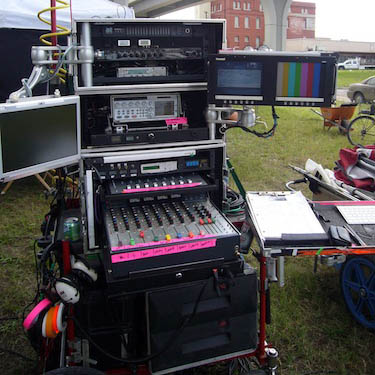|
 Production mixer for Sony Pictures 2011 release Battle: Los Angeles, Paul Ledford used Metric Halo's new ULN-8 interface to handle the dialogue and sound effects with ease and incredible sonic quality in a very small footprint. Production mixer for Sony Pictures 2011 release Battle: Los Angeles, Paul Ledford used Metric Halo's new ULN-8 interface to handle the dialogue and sound effects with ease and incredible sonic quality in a very small footprint.
LOS ANGELES, CALIFORNIA: The capabilities of digital audio have brought about a paradigm shift in motion picture location sound recording over the past decade, away from traditional analog hardware to more versatile software-based solutions. As production mixer Paul Ledford, C.A.S. recently discovered, a digital audio solution such as Metric Halo's ULN-8 interface can also handle the increasingly more complex demands of a modern-day film shoot, and may well herald the next step in the evolution of location sound.
Ledford recently finished work on Jonathan Liebesman's Battle: Los Angeles, a Sony Pictures movie about a group of U.S. Marines confronting and combating an alien invasion, which placed some unusual demands on the mixer's location sound cart setup. The multi-camera shoot involved many busy action scenes with a lot going on at once, he says, and with very little rehearsal. "And the director wanted everybody miked - which is a growing mantra in our business," states Ledford, a production mixer who has a resume that includes projects, Traffic, Ocean's Eleven (and Twelve and Thirteen), The Good German, 12 Rounds, In The Electric Mist, and Sling Blade to name a few.
With a need to record fourteen, and occasionally as many as sixteen, individual dialog and sound effects tracks, Ledford went in search of a setup that could be scaled up or down in track count without requiring a refit of his sound cart, which also needed to remain compact and mobile. Following the recommendation of Peter Schneider, co-owner of the Gotham Sound sales and rental house in New York, Ledford took a closer look at the new Metric Halo ULN-8 interface.
"I had used the Metric Halo MIO 2882 for a previous project for playback and also some surround recording," Ledford reports. "That led me to constructing a box using the ULN-8 and a Euphonix MC Mix control surface. I had a MacBook built into an Axiotron ModBook. We maxed out the memory to 6GB and added internal and external solid state drives. After thinking how much we were using CPU cycles and the fact that Metric Halo does a lot of its own onboard processing, I felt comfortable going that way."
A mix of lavalier, boom, M-S stereo and plant microphones captured on-set dialog and background sounds, which were transmitted wirelessly to the ULN-8's inputs. The ULN-8 then fed Ledford's Cooper 208D eight-channel mixer, newly modified by Evan Mater of Vark Audio to allow the insertion of external inputs directly to the internal busses.
"The preamp levels would be set, those inputs would be mixed, they would flow into the buss in the Cooper and the Cooper faders would be mixed. Tracks one and two were used as the split mix. Everything would go to the A-to-D converters on the Cooper and then to the Deva 16-track digital recorder," he elaborates. The ModBook tablet with internal SSDs functioned as a backup recording device.
"We didn't task the MIO like some of the music folks. The only plug-ins I used were EQ and possibly a limiter. We were doing very basic recording and signal path routing to take care of all the necessary outputs and aux sends, but this system could be turned on for those days or that particular scene that we were going to cover and would allow me to expand beyond what I have been working on for years. Metric Halo gives me the sonic quality that I'm used to, operates on DC power, lived within the same footprint that I have in my cart, and was shoved into a van that we could drive down the street. Metric Halo really fits the bill," he reports.
"There was certainly a learning curve, but the way the ULN-8 is configured, and the programming that they've put inside, I think down the road it could certainly be the future of how we do mixes on set," he comments. Track counts beyond ten or twelve are becoming less unusual, and where less isolated dialog tracks are required any spare tracks are useful for recording on-set effects or backgrounds in-sync with production dialog, to make temp mixes much more fleshed out, and possibly to add another level of realism to the final mix, he says. Having been up against the ten-channel limit of his regular rig on Sylvester Stallone's The Expendables last year, Ledford was thankful for his expanded capabilities on this latest project. "We thought we'd only use that system for a portion of Battle: Los Angeles but in fact we used it for the entire show."
"Some folks are going to be caught in the dilemma of what they do when they've been so used to working with eight tracks," he observes." Metric Halo for me was a no-brainer, for being able to come out of the Cooper to the 2882, and between the 2882 and the ULN-8 combine all those tracks and record it inside a computer as a backup. Not everyone trusts the fader board or computers, especially older mixers who grew up with hardware. But I have to say, we did not have any issues on set. It never had a crash. We had nothing but success. Support from Metric Halo is also great. The few times I needed them, they were always there to take the call and answer the email." |